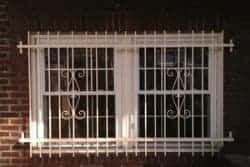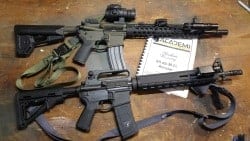If a burglar, kidnapper, or home invasion robbing crew targeted your home, it would be good if your home were a hard target, like a castle for the fortress of the ancient days, but the reasonableness of your security measures must take into account the likelihood and severity of the risks you might face.
Let’s go over some ways to make your home more secure, focusing on hardware and structural changes, not skills or techniques to learn.
SKIP AHEAD
Fortifying Your Home: Things to Consider
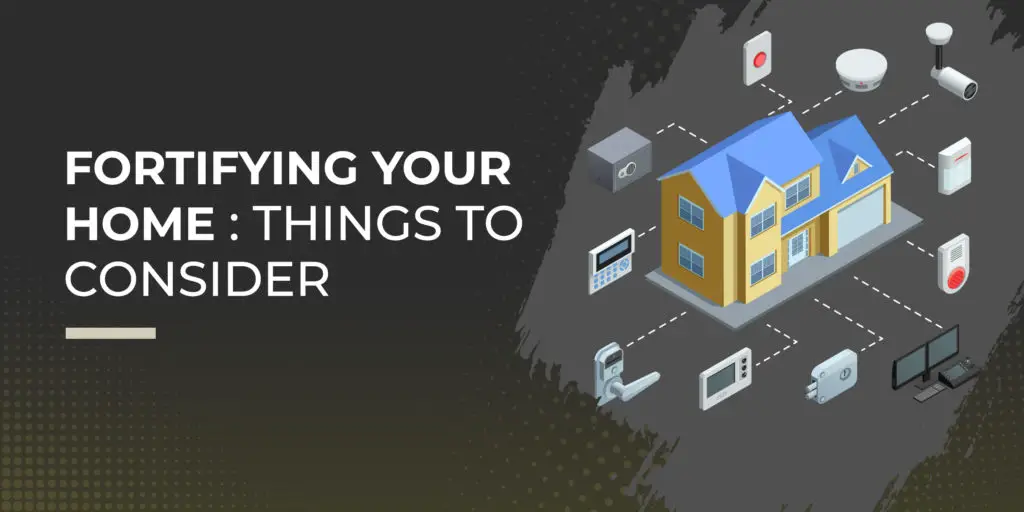
Most people have already considered moderately-effective security improvements such as getting an alarm system, installing deadbolt locks on exterior doors, installing exterior lighting all around your home, trimming trees and shrubs around windows, and getting a dog. Almost everybody reading this article will already own one or more “home defense” firearms. These are all good steps, but so much more can be done.
For the purposes of this article, let us acknowledge that unless your home is built from the foundation up like a fortress, you cannot expect any security measures to stop a determined team of burglars who are willing to take some time and make noise to get inside.
If they come when you are home, your security precautions can give you a warning so that you can put your defensive plan into effect. If you are not home, your alarm and other security measures could give cops or your neighbors time to respond.
Check out this detailed blueprint on how to prepare your home
First Objective: Know They’re Coming

In order to defend your home and/or quickly send other people to defend your home in your absence, the first thing you need to know is that an attack on your home is beginning. It would be desirable to see the arrival of the criminals on your property. For this, you want windows or cameras looking out into your yard from every direction– the street, the sides, and the back yard.
Windows and cameras
Every side of your home should have windows from which you can see out. Upper floor windows make for safer viewing out and are less vulnerable to being entry points for intruders. Windows are also potential defensive positions for you and your family to try to drive off or repel the attackers.
Virtually all security-sensitive businesses, government offices, and the homes of VIPs have a No products found. as part of the security plan. Today’s security cameras often come with infrared lights to work–with limited range–even in total darkness. We would all be safer if we had them for our homes. A peephole can be more useful than a window sometimes.
All your exterior doors should have one-way peepholes in them, preferably with wide-angle lenses so you can see people standing to the side of the door.
Check out SurvivalCache’s recommended surveillance systems:
Exterior lighting
Motion detector activated lighting is important, as are Onforu 60W LED Flood Lights Outdoor, Super Bright Security Light, 6500K... that you can also turn on with a switch. They should be positioned to shine away from your home, so that you can see out without getting any glare, and without the lights making you visible from the outside. If one side of your home has no windows, consider mounting a camera there.
Studies show that good lighting of your home and yard at night is one of the most cost-effective methods of home security to discourage burglars.
Check out SurvivalCache’s recommended floodlights:
Last update on 2024-04-17 at 16:53 / Affiliate links / Images from Amazon Product Advertising API
Perimeter motion detectors
Another way of knowing when somebody is coming onto your property is to use a perimeter warning circuit in your home alarm system. Most home alarm systems will accommodate this kind of addiction, but most homeowners do not upgrade to this level of protection.
Perimeter detection can be either of two popular types: wide-area motion detectors or beam-break detectors. Both kinds are available with two kinds of underlying technologies: passive infrared light, or microwave signals.
Related: Handling an Active Shooter Situation
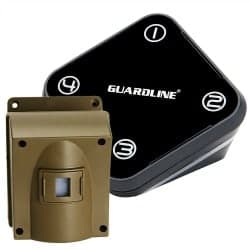
Perimeter warning units mount outdoors around your home and yard, on posts, tree trunks, or the side of your home. Wide area motion detectors will alert to a human or large animal’s movement in your yard, within a cone-shaped zone. Beam-break type detectors come in sets of two units, and one projects a beam toward the other, and the line between the sending unit and receiving/reflecting unit is the “beam” that is being monitored.
If anything crosses that line, its body will temporarily block the beam of infra-red light, and the alarm is triggered. The more common models that you might buy at a big box home improvement store use IR light, and they have a range of about 50-75 feet. The commercial models used by businesses are more expensive, but reach out to over 300 feet.
Perimeter alarm systems work best in conjunction with physical barriers around your property, such as fences, and a gate across your driveway to slow the approach of unwelcome vehicles. These barriers serve to give you more of a warning, as the criminals approach will be slower and noisier.
Check out SurvivalCache’s recommended perimeter systems:
 Best System
|
|
Check Price on Guardline's Site
Check Price on Amazon.com
|
Second Objective: Block Their Entry
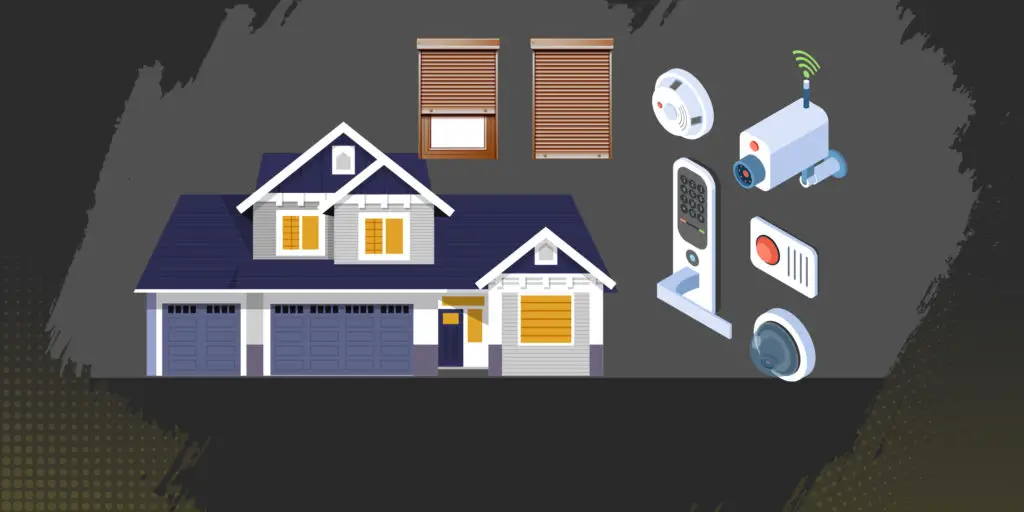
If criminals attack your home, you want them to find all your doors and windows closed and locked. They may try to break through one of these points of entry, probably a back door, where they cannot be seen from the street or may not be visible to the neighbors. You want your doors to resist being pried-open or kicked-in. Here is how you can make your exterior doors stronger:
Strong exterior doors
Not all doors are equal when it comes to construction. Some are thin molded plastic glued to a wooden frame. Others have steel sheet metal over a wooden frame. Wood is weaker than fiberglass and undesirable in a high-security door.
Even solid wood doors, though strong across the middle, are weak where they are drilled-out for the lock components. Commercial fire-rated steel doors are stronger than ones made for residential applications, but they’re a lot more expensive. Choose a door that does not have windows in it, especially if that glass is located close enough to the lock mechanism that a criminal could smash the glass and reach through to the lock.
The weakest link of the door itself is where it has been hollowed-out for the lock sets– the door material here is pencil-thin and easy to rip away from the metal lock components.
High-security locks and door-mounting hardware
A standard exterior door lock has a short bolt that only engages a tiny bit into a recess in the door frame. A deadbolt, mounted several inches above the standard doorknob, gives you a second bolt with a much longer range of motion; it will often reach over an inch into the door frame. Make sure the fit of the door to the door frame and the strike plate is good, with a very small gap. Many locking doors have a lockset that is supposed to prevent easy opening with a stiff plastic like a driver’s license but in the real world sloppy installation or the loosening of the door frame over cause misalignment that will allow anybody to “jimmy” the lock.
To address the inherent weakness in doors and door frames due to flimsy and thin wood components that surround the lock parts themselves, buy door security hardware (such as Armor Concept’s Door Armor Max) that lets you screw steel reinforcing plates or “wrap-around” over the part of the door that has the lock mechanism. You can also reinforce your strike plate, which is the rectangular metal piece surrounding the hole in the door frame into which the bolt of the lock will enter.
In addition to bolting steel plates to your door around the lock mechanism, as reinforcements to the door itself, you should use bigger, longer screws in and around your door. Replace the short, skinny nails and screws that your door was installed with. Use deck screws, which come in lengths of over 3.5 inches.
Check out SurvivalCache’s recommended products:
| PRODUCTS | FEATURES | ||
|---|---|---|---|
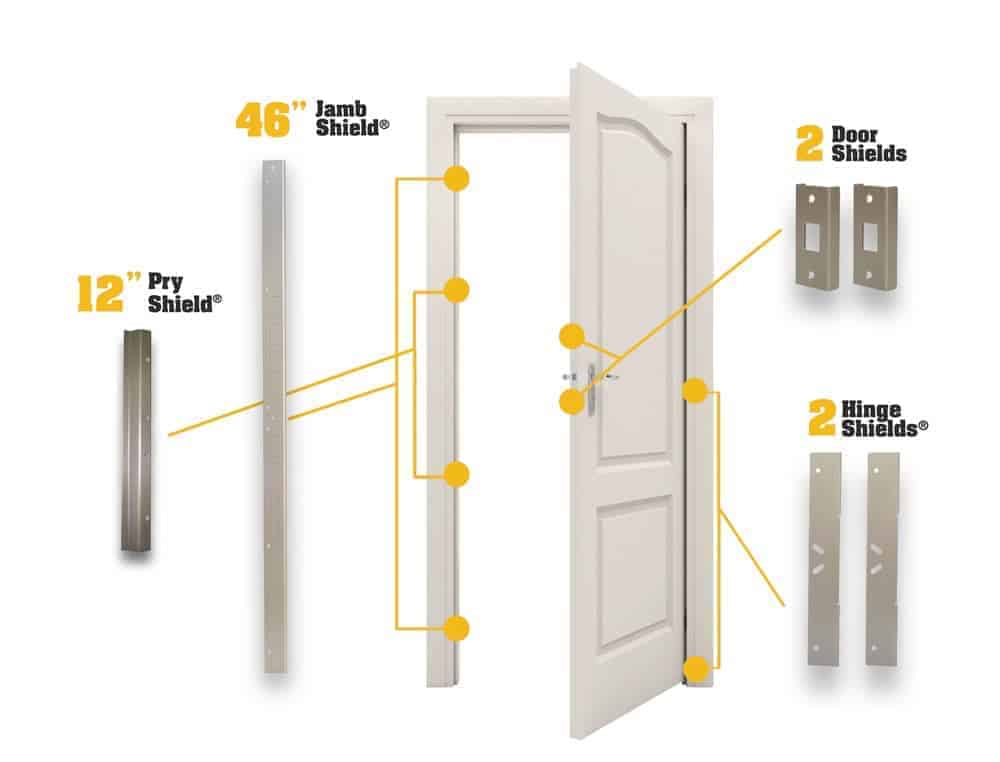 Must Have
|
|
Check Price on Armor Concepts site (15% OFF)
Check Price on Amazon.com
|
|

Recommended
|
|
Check Price on Amazon.com
|
Augment your door’s locks with an external bar
Remember, no matter how good your door’s locks are, the bolts can be cut with modern cordless power tools. Criminals have been known to use such battery-powered tools to cut chains and locks. Another way to prevent a door from being forced open is to use a locking bar that is propped against the door at a 45-degree angle. Some such bars require a slot or stud hole in your floor, but others use a rubber-coated end and friction to prop the bar in place.
Reinforce your windows
As for windows, the most obvious problem is that a criminal can break the glass, reach-in, unlock the window sash, open the window, and climb in. To make your windows stronger, consider putting up another layer of barrier in addition to the glass panes. Some people use rigid panes or sheets of clear plastic, and this is good if the type of plastic is polycarbonate, such as the brand Lexan.
Do not use cheap acrylic plastic, it is not particularly strong nor shatter-resistant. There are also “security film” window treatments on the market. They are tough but flexible wraps of clear (or tinted) plastic that apply to glass doors and windows just as one would apply tint film to car windows. This security film will hold the window together even when the glass underneath is broken. It is tough enough and energy-absorbing enough that it can’t easily be ripped away to create a big opening for an intruder to climb through.
However, a window’s sashes or frame can be smashed-through, just like a door. That’s why some people in high crime areas fortify their windows (and sometimes doors) with burglar bars. These bars cover the entire window opening with a cage or screen. They are much less attractive than clear plastic.
Although they look “ghetto,” they are high security. One risk that comes from covering your windows with burglar bars is that it will often prevent the window from opening. You should consider whether you might need to use that window for ventilation or for an emergency escape, such as in case of a fire. Some burglar bar sets have a quick-release system, accessible only from the inside of the home.
Check out this detailed blueprint on how to prepare your home
Secure Basement Windows
Basement windows can be easy to overlook as they have a low profile on the house and are sometimes even below the surface of the ground.
They also tend to be overlooked due to their small size, but this is a mistake.
You would be surprised at how small a space the human body can slide into when it wants to. Besides, not all burglars are six and a half feet tall weighing in at two hundred and seventy-five pounds.
Burglar Bars
One option, as mentioned earlier is to add burglar bars on the exterior of the window. Aesthetically, this would not be as bad as having them on the main windows because basement windows are not as noticeable due to their size and location.
Burglar bars are a strong reinforcement for an otherwise weak entry point.
Changing Out the Window
There are a variety of different types of basement windows that range from sliders, awnings, and hopper styles just to name a few.
Depending on how a basement is used, a window that opens could be replaced with one that does not, such as a glass block window.
These are made from thick pieces of glass that are permanently laid within a window frame like how bricks are laid out.
Glass blocks still allow natural light in but are more difficult to break than a standard window.
Brick it Up
Of course, if you really want to secure a basement window one of the best options is to completely remove the window as a point of entry by covering it cement or bricks.
This may require removing both the window and its frame before the opening can be filled in with bricks.
Most homeowners may find this task difficult to complete properly and may need to hire the help of a handyman or contractor.
Secure Garage Doors
A garage door is another point of entry that most people feel is relatively safe. But there are several ways to get past a garage door.
Digital security keypads that require a code to open a door are not an absolute safeguard.
They can be physically bypassed, or the act of inputting a code could easily be observed by someone sitting across the street with a pair of binoculars.
I have also overheard kids telling their friends security codes for when they come over at some point to hang out.
Then there are doors with exterior handles with keyed locks on the exterior of the garage door. These locks can be picked or simply broken.
Lastly, if the sequenced code to a garage door opener is copied or discovered then the door can be opened by an outside controller.
Blocking the Main Door
Ultimately, the best way to secure a garage door is to prevent the door from moving along the interior track.
While this process requires consistency on the part of the homeowner, there are two simple ways to accomplish this.
Some tracks have holes spaced out along them in which a large padlock could be placed into.
Secondly, a large metal bar or wood beam could be placed across the door and track.
Both methods prevent the door from rolling up the track when the motor is engaged or when someone on the outside attempts to physically lift the door up.
Garage Side Doors and Windows
Do not forget to secure any side doorways or windows that may be part of your garage.
These can be overlooked because we view the large garage door as the barrier that will keep people out, but any entry point is a week point.
Use any of the above methods in this article to secure these extra windows and doors.
Doggy Doors
Traditional doggy doors are one of the worst things a home can have because it provides instant access to the interior of a home without a door or window needing to be broken.
It is literally a hole in the door.
Even if an individual is too large to fit through the opening, a doggy door provides quick access that allows a person to get a look inside or as a means for unlocking the door itself.
There have many accounts of people who did not know how they were robbed because there were no signs of forced entry. That is until later when they found out the intruder used the doggy door to gain access to the home.
The best security advice for dealing with a doggy door is to get rid of it. Repair and fill in the area where the doggy door is located or better yet, get a new solid door.
Doggy Door Alternative
If you feel you must have a door for your pet, it is best to stay away from the traditional two-way style doors.
Instead, install a solid one-way door that can be locked from the inside. By using a door like this the entry point can be shut and secured when not in use instead of having a doorway that is unsecured 24/7.
Sliding Windows
Some burglars want to make the least amount of noise as possible so as not to draw attention to themselves.
Instead of breaking doors or windows, they will go around checking different entry points hoping to find one that is not locked.
You would be surprised at how often a window or door is left unlocked, which gives a person on the outside easy and silent access.
A simple way of securing slide windows from the inside is to insert a wooden dowel into the track of the window.
The dowel physically blocks the window from moving even if the window is left unlocked.
It is an incredibly cheap and simple alternative to burglar bars and is almost unnoticeable.
The downside is that the glass can still easily be broken and the window used as an entry point.
Natural Barriers
Oddly, natural barriers are not given a lot of thought these days. This is usually because they are aesthetically unpleasing and thus removed.
These barriers work best in rural areas where they naturally grow or can be planted but they can be utilized in some urban environments.
Along the perimeter of a property certain plants, bushes, or trees can be planted that would make it difficult for a person to overcome.
Some of the best choices are plants that have thorns.
For example, blackberry bushes have tough, sharp thorns on the plant. If you have never become entangled in a blackberry patch, let me tell you it is an annoying, painful, frustrating ordeal that takes time to get out of.
Thick patches of similar vegetation can be planted that would eliminate accessible routes onto a property. Thus, leaving only one point of entry that can be observed and protected easier.
Urban Barriers
It is usually advised to keep plant life near a home trimmed. Tall, thick shrubbery for example gives intruders a place to hide while conducting their business.
However, if the bushes or plants have characteristics good for security purposes, such as thorns or tough pointy needles and leaves, it would be better to allow them to grow and fill an area in.
But in some cases, it does help to trim or remove natural barriers to better fortify a home.
For instance, a large tree growing near a fence or alongside the home can act as a ladder. This will allow a person to easily scale a tall fence or gain access to the second floor of a home.
Timers
Timers can be implemented to turn on lights, televisions, and other devices at a pre-determined time that gives the illusion of a person being in the home.
The use of timing devices has been shown to detour would-be thieves.
While these are not a physical barrier, given their affordability, ease of use, and simple installation I believe they are worth considering for the topic at hand.
Third Objective: Have Hard Cover in Your Home

If intruders made it through your doors and windows and get into your home, while you and your family are there, one or more of you may want to fight off the intruders, while others escape, either by leaving the home or locking themselves in a safe room.
Safe room. A safe room is a place inside your home for you to stay out of sight and out of reach of intruders, even if that means the intruders can steal anything they want from the rest of your home. It should be a room that is very hard to break-into, and one that is equipped for you to comfortably stay there for a long time. The door to the safe room should be an exterior grade door, or a fire-rated door suitable for commercial construction. It should have good locks and lock-reinforcing hardware installed as described previously in this article. The door should have a one-way, wide-angle peephole.
If you were building or remodeling your home, I would suggest making the walls of one of the smaller rooms in your home (a guest bedroom, big bathroom, or a large walk-in closet) extra strong for future use as a safe room.
For this room, you may want to put a steel mesh screen across the studs before you enclose them with sheetrock (drywall). A good type of screen for this purpose is “remesh” made for reinforcing poured concrete driveways. You may want to have the studs placed at 8” center to center instead of the normal 16” spacing, to make it impossible for an intruder to rip through the flimsy sheetrock and step into that room bypassing his body in between the 2×4 studs. Or you could use sheets of plywood to cover those walls first, and then use drywall.
The safe room should also have weapons inside it to deal with the intruders should they manage to break into that room. You should also have an axe and pry bar in that room so that you can break OUT of it, if necessary, if for some reason that strong door was blocked or its lock jammed so that you could not open it.
Consider what is “cover” inside your home. If you had to grab a gun and fight intruders, would it be to your advantage to position yourself behind bullet-resistant cover? Of course, it would. Every tactical shooting course and every instructor on the topic of combat arms shows you how to make use of cover while engaging your adversary. Inside your home, think of what you have, or could that would serve as cover.
Keep in mind that cover is not the same as concealment. Concealment just hides you from sight. Doors are concealment. Even the interior walls of your home only “conceal” you from the bad guys, but interior walls will not stop incoming bullets. The cover is defined as something that effectively blocks or deflects bullets.
With your knowledge of the layout of your home, you should anticipate the likely point of entry for intruders, and you should choose a few defensive positions in your home. Don’t count on the corners of walls, or doorways, as reliable cover. All popular handgun and rifle bullets, as well as buckshot or slugs from a shotgun, will go right through interior walls easily, with lethal velocity as they emerge on the other side.
The only parts of an interior wall that can stop or significantly slow down handgun bullets are the wooden wall studs– and there is only one stud per 16 inches of wall length in most walls. If the bullet hits any of the other 15 inches along that section of wall, it encounters only a couple layers of drywall. Bullets go through drywall like a knife through butter.
A bookcase whose shelves are filled with books and other paperwork can stop bullets. A refrigerator full of food and beverages will stop handgun bullets and buckshot from a shotgun, and some small, high velocity rifle bullets. The same applies to ovens, washers, and dryers– consider them “cover” as to most common handguns, but not for rifle rounds. Furniture is no good as cover. Wooden chairs and tables don’t usually stop even pistol bullets, and upholstered furniture like sofas and reclining chairs are only “concealment” if you duck behind them, not cover. Your bedroom dresser, with the drawers full of clothes, makes better cover than the mattress and box spring of your bed.
Conclusion
In times of peace and relative safety, certain security measures are more “worth it” than others. It all depends on the risks you and your home face, and how much peace of mind you would attain from having a fortified home with a good security system.
Because conditions in our society could change rapidly, it may not be unreasonable to beef up your home now, when you have easy access to all the hardware at the local shopping center. In times of trouble, the roads may be more hazardous for travel and the hardware and home supply stores could be closed or sold out of the products you need. It’s better to prepare now.
Check out this detailed blueprint on how to prepare your home




